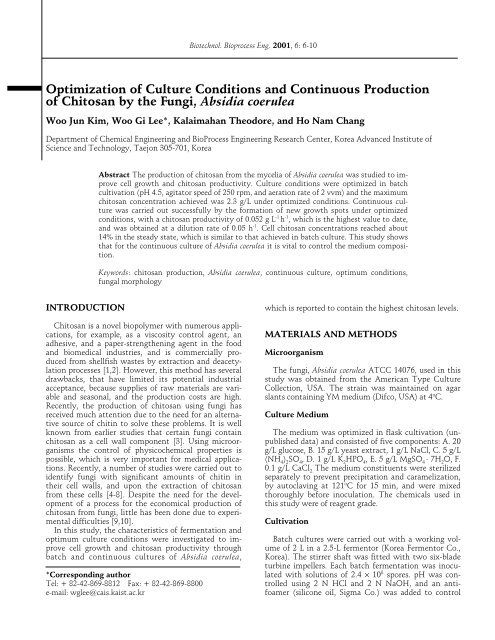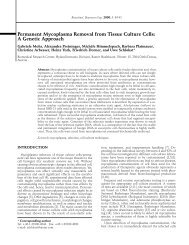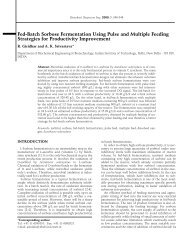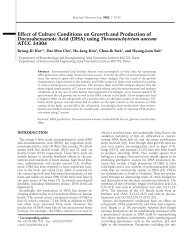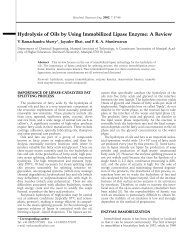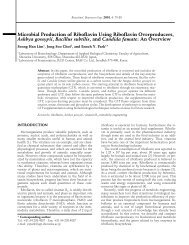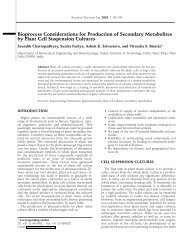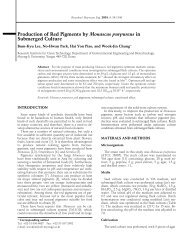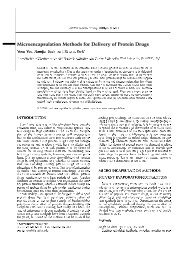Optimization of Culture Conditions and Continuous Production of ...
Optimization of Culture Conditions and Continuous Production of ...
Optimization of Culture Conditions and Continuous Production of ...
Create successful ePaper yourself
Turn your PDF publications into a flip-book with our unique Google optimized e-Paper software.
Biotechnol. Bioprocess Eng. 2001, 6: 6-10<strong>Optimization</strong> <strong>of</strong> <strong>Culture</strong> <strong>Conditions</strong> <strong>and</strong> <strong>Continuous</strong> <strong>Production</strong><strong>of</strong> Chitosan by the Fungi, Absidia coeruleaWoo Jun Kim, Woo Gi Lee*, Kalaimahan Theodore, <strong>and</strong> Ho Nam ChangDepartment <strong>of</strong> Chemical Engineering <strong>and</strong> BioProcess Engineering Research Center, Korea Advanced Institute <strong>of</strong>Science <strong>and</strong> Technology, Taejon 305-701, KoreaAbstract The production <strong>of</strong> chitosan from the mycelia <strong>of</strong> Absidia coerulea was studied to improvecell growth <strong>and</strong> chitosan productivity. <strong>Culture</strong> conditions were optimized in batchcultivation (pH 4.5, agitator speed <strong>of</strong> 250 rpm, <strong>and</strong> aeration rate <strong>of</strong> 2 vvm) <strong>and</strong> the maximumchitosan concentration achieved was 2.3 g/L under optimized conditions. <strong>Continuous</strong> culturewas carried out successfully by the formation <strong>of</strong> new growth spots under optimizedconditions, with a chitosan productivity <strong>of</strong> 0.052 g L -1 h -1 , which is the highest value to date,<strong>and</strong> was obtained at a dilution rate <strong>of</strong> 0.05 h -1 . Cell chitosan concentrations reached about14% in the steady state, which is similar to that achieved in batch culture. This study showsthat for the continuous culture <strong>of</strong> Absidia coerulea it is vital to control the medium composition.Keywords: chitosan production, Absidia coerulea, continuous culture, optimum conditions,fungal morphologyINTRODUCTIONChitosan is a novel biopolymer with numerous applications,for example, as a viscosity control agent, anadhesive, <strong>and</strong> a paper-strengthening agent in the food<strong>and</strong> biomedical industries, <strong>and</strong> is commercially producedfrom shellfish wastes by extraction <strong>and</strong> deacetylationprocesses [1,2]. However, this method has severaldrawbacks, that have limited its potential industrialacceptance, because supplies <strong>of</strong> raw materials are variable<strong>and</strong> seasonal, <strong>and</strong> the production costs are high.Recently, the production <strong>of</strong> chitosan using fungi hasreceived much attention due to the need for an alternativesource <strong>of</strong> chitin to solve these problems. It is wellknown from earlier studies that certain fungi containchitosan as a cell wall component [3]. Using microorganismsthe control <strong>of</strong> physicochemical properties ispossible, which is very important for medical applications.Recently, a number <strong>of</strong> studies were carried out toidentify fungi with significant amounts <strong>of</strong> chitin intheir cell walls, <strong>and</strong> upon the extraction <strong>of</strong> chitosanfrom these cells [4-8]. Despite the need for the development<strong>of</strong> a process for the economical production <strong>of</strong>chitosan from fungi, little has been done due to experimentaldifficulties [9,10].In this study, the characteristics <strong>of</strong> fermentation <strong>and</strong>optimum culture conditions were investigated to improvecell growth <strong>and</strong> chitosan productivity throughbatch <strong>and</strong> continuous cultures <strong>of</strong> Absidia coerulea,*Corresponding authorTel: + 82-42-869-8812 Fax: + 82-42-869-8800e-mail: wglee@cais.kaist.ac.krwhich is reported to contain the highest chitosan levels.MATERIALS AND METHODSMicroorganismThe fungi, Absidia coerulea ATCC 14076, used in thisstudy was obtained from the American Type <strong>Culture</strong>Collection, USA. The strain was maintained on agarslants containing YM medium (Difco, USA) at 4 o C.<strong>Culture</strong> MediumThe medium was optimized in flask cultivation (unpublisheddata) <strong>and</strong> consisted <strong>of</strong> five components: A. 20g/L glucose, B. 15 g/L yeast extract, 1 g/L NaCl, C. 5 g/L(NH 4) 2SO 4, D. 1 g/L K 2HPO 4, E. 5 g/L MgSO 4⋅ 7H 2O, F.0.1 g/L CaCl 2.The medium constituents were sterilizedseparately to prevent precipitation <strong>and</strong> caramelization,by autoclaving at 121 o C for 15 min, <strong>and</strong> were mixedthoroughly before inoculation. The chemicals used inthis study were <strong>of</strong> reagent grade.CultivationBatch cultures were carried out with a working volume<strong>of</strong> 2 L in a 2.5-L fermentor (Korea Fermentor Co.,Korea). The stirrer shaft was fitted with two six-bladeturbine impellers. Each batch fermentation was inoculatedwith solutions <strong>of</strong> 2.4 × 10 8 spores. pH was controlledusing 2 N HCl <strong>and</strong> 2 N NaOH, <strong>and</strong> an antifoamer(silicone oil, Sigma Co.) was added to control
Biotechnol. Bioprocess Eng. 2001, Vol. 6, No. 1 7 Fig. 1. Effect <strong>of</strong> pH on cell growth <strong>and</strong> chitosan production. Fig. 2. Effect <strong>of</strong> agitator speed on cell growth.the form produced during the fermentation. 50-mLsamples were withdrawn at designated times duringthe fermentation.For chemostat culture, the fermentor was operatedbatchwise untill a moderate cell concentration was obtained<strong>and</strong> then operated continuously at a dilution rate<strong>of</strong> 0.05 h -1 . The liquid level in the fermentor was controlledat a fixed value so that the inlet flow rate wasexactly equal to the outlet flow rate. Medium feedingrate <strong>and</strong> outlet flow rate were adjusted by a peristalticpump (Cole Parmer Co., USA).AssaysGlucose was measured by an enzymatic (GOD/PODglucoseoxidase/peroxidase) method (Glucose-E kit,Yeoungdong Pharm. Inc., Korea) at 505 nm using aspectrophotometer (Spectronics 21, Milton Roy Co.).Spore number was counted using a hemocytometer(American Opticals Inc., USA) <strong>and</strong> cell dry weight wasdetermined after filtering the cell suspension using avacuum pump, through Toyo No. 5A filter paper, washingthe cells in distilled water, <strong>and</strong> drying with a vacuumdryer. Chitosan was extracted according to themethod described by Rane <strong>and</strong> Hoover [11].RESULTS AND DISCUSSIONEffect <strong>of</strong> pH<strong>Culture</strong> conditions for batch fermentation were determinedusing the medium optimized in flask culture,which contained 20 g/L glucose, 15 g/L yeast extract,<strong>and</strong> 5 g/L (NH 4) 2SO 4(Figs. 1-3). Fig. 1 shows the effect<strong>of</strong> pH on cell growth <strong>and</strong> chitosan production by Absidiacoerulea ATCC 14076. pH decreased from 6.3 to 4.8during cell growth under these conditions, which werewithout pH control. The initial rate <strong>of</strong> cell growth <strong>and</strong>the maximum growth rate were improved by controllingthe pH at 4.5. However, the growth rate at pH 4.5drastically decreased after 50 h <strong>and</strong> the dry cellweight after 72 h was 20 g/L, which was similar to thatwithout pH control <strong>and</strong> was due to substrate depletion.pH affected fungal morphology <strong>and</strong> smaller pellets wereformed at pH 4.5 as compared to those formed withoutpH control. Reducing autolysis improved the growthrate.With pH controlled at 4.5 the maximum chitosanconcentration was 2.3 g/L <strong>and</strong> the percentage <strong>of</strong> chitosanin the cell reached 13.7 on dry weight basis after 36hours <strong>of</strong> cultivation. Whereas without pH control, thechitosan concentration only reached 1.3 g/L after 72hours <strong>of</strong> cultivation. When the cells were cultivated for72 h at a controlled pH <strong>of</strong> 4.5, the chitosan concentration<strong>and</strong> yield decreased, though there was an increasein the cell concentration. From these results it is evidentthat the pH <strong>and</strong> cell harvest time must be controlled tomaximize the chitosan concentration.Effect <strong>of</strong> Agitator SpeedDifferent strains have their own specific requirementsto develop a morphology capable <strong>of</strong> a highgrowth rate. The determination <strong>of</strong> strain morphology isintrinsic but can be highly influenced by shear forces inthe fermentor [9,12]. The effect <strong>of</strong> agitator speed ongrowth <strong>and</strong> morphology was studied in batch cultivation(Fig. 2, Table 1). Sterile air was added at a rate <strong>of</strong> 1vvm to provide adequate air for cell growth. The spores<strong>of</strong> Absidia coerulea germinated at about 18 h, <strong>and</strong> cellsthen grew at an exponential rate, which later declinedduring the course <strong>of</strong> cultivation. At an agitator speed <strong>of</strong>250 rpm, ca. 17 g/L (dry cell weight) was obtained at 72h <strong>and</strong> growth was maximal. Whereas the growth ratewas very low <strong>and</strong> a cell concentration was only ca. 5g/L at 350 rpm (Fig. 2). Optimum agitator speed for cellgrowth was 250 rpm.A lower agitator speed <strong>of</strong> 150 rpm caused the formation<strong>of</strong> smooth hollow pellets <strong>of</strong> 2-3 mm diameter dueto autolysis caused by <strong>of</strong> oxygen <strong>and</strong> mass transfer difficultiesinto the pellet (Table 1) [13]. More compactpellets <strong>of</strong> size 0.3-0.5 mm were formed at 250 rpm.However, pellets were not formed <strong>and</strong> cell morphology
8 Biotechnol. Bioprocess Eng. 2001, Vol. 6, No. 1Table 1. Effect <strong>of</strong> agitator speed on cell morphologyAgitator Speed (rpm) 150250350 GranularMorphologyPellet Type: Smooth <strong>and</strong> HollowDiameter: 2-3 mmPellet Type: CompactDiameter: 0.3-0.5 mm Fig. 3. Effect <strong>of</strong> aeration on cell growth.was granular at speeds higher than 350 rpm due to thehigher shear rates. From these results, it is vital to controlagitator speed to form compact pellets <strong>and</strong> obtainhigh cell concentrations.Effect <strong>of</strong> AerationAutolysis also took place in the mycelial pellets dueto difficulties in oxygen transfer, <strong>and</strong> therefore, the effect<strong>of</strong> aeration on cell growth was studied (Fig. 3). Thefermentation was carried out at 250 rpm, which gavegood cell growths. Initial growth rate was slow up to 20h <strong>of</strong> cultivation for both 1 vvm <strong>and</strong> 2 vvm. Due to ahigh rate <strong>of</strong> shear, pellet formation was initially slowwhen the aeration rate was 2 vvm. However, at thisaeration rate, the growth rate increased after 20 h <strong>and</strong>the final cell concentration reached 10% more than thatobtained at 1 vvm. Aeration at 2 vvm could also haveprevented cell agglomeration <strong>and</strong> adhesion <strong>of</strong> myceliato baffles, impellers, <strong>and</strong> the fermentor wall.The optimum conditions for cell growth <strong>and</strong> chitosanproduction in the batch cultivation <strong>of</strong> Absidia coeruleaATCC 14076 were pH 4.5, agitator speed <strong>of</strong> 250 rpm,<strong>and</strong> an aeration rate <strong>of</strong> 2 vvm. The maximum specificgrowth rate obtained was 0.08 h -1 under these optimumconditions. Maximum chitosan concentration <strong>and</strong> chitosanyield based on glucose were 2.3 g/L <strong>and</strong> 11.5%respectively at a cell harvest time <strong>of</strong> 36 h. This chitosanconcentration is about 5 times <strong>of</strong> that obtained by Rane<strong>and</strong> Hoover [10] in batch culture using the same strain. Fig. 4. <strong>Continuous</strong> culture <strong>of</strong> Abisidia coerulea at a dilutionrate <strong>of</strong> 0.05 h -1 (pH 4.5, agitator speed <strong>of</strong> 250 rpm, <strong>and</strong> aerationrate <strong>of</strong> 2 vvm).<strong>Continuous</strong> <strong>Culture</strong> <strong>Continuous</strong> fermentation was carried out to obtainhigh productivity <strong>and</strong> produce chitosan with uniqueproperties. However, Davoust <strong>and</strong> Hansson [9] reportedthat continuous cultivation was difficult to establishdue to the lack <strong>of</strong> new growth spots <strong>and</strong> accretedgrowth. To prevent washout <strong>and</strong> the formation <strong>of</strong> newpellets in the continuous culture, the spores need to bereleased from pellets or the mycelia may rupture. However,Absidia coerulea, which belongs to Zygomycetes,could not form septa <strong>and</strong> the rupture <strong>of</strong> mycelia wasnot easy [13]. The pellet structure is very important forcontinuous culture.Generally, the medium composition does influencethe pellet structure [12]. Table 2 shows two differentmedia <strong>and</strong> culture conditions adopted in continuousculture that have been reported to date. We investigatedthe effect <strong>of</strong> medium composition on cell morphology(data not shown). High ammonium sulfateconcentration <strong>and</strong>/or chelating agent like Fe-EDTA inthe medium gave smaller <strong>and</strong> more compact pellets, asreported by Metz <strong>and</strong> Kossen [12], <strong>and</strong> probably madethe release <strong>of</strong> spores impossible.We examined the possibility <strong>of</strong> continuous cultivationusing optimized culture conditions (pH 4.5, agitatorspeed <strong>of</strong> 250 rpm, <strong>and</strong> aeration rate <strong>of</strong> 2 vvm) <strong>and</strong>an optimized medium which probably created newgrowth spots (Fig. 4). <strong>Continuous</strong> culture with a dilutionrate <strong>of</strong> 0.05 h -1 was started with an initial cell concentration<strong>of</strong> ca. 1 g/L; the cell concentration then increaseduntil it reached steady state. At the steady state,the concentrations <strong>of</strong> cell <strong>and</strong> residual glucose wereabout 7 g/L <strong>and</strong> 10 g/L respectively. Chitosan productivityobtained in this study was 0.052 g L -1 h -1 , which ishigher than that reported by Rane <strong>and</strong> Hoover [10].The cell chitosan level was about 14% at the steadystate, which was similar to that obtained in batch culture.
Biotechnol. Bioprocess Eng. 2001, Vol. 6, No. 1 9Table 2. Comparison <strong>of</strong> the results <strong>of</strong> two previous trials <strong>of</strong> continuous culture with the present workDavoust <strong>and</strong> Hansson [9] Rane <strong>and</strong> Hoover [10] This workStrain Absidia coerulea Absidia coerulea Absidia coeruleaCarbon Source Glucose 20 g/L Glucose 20 g/L Glucose 20 g/LNitrogen SourceYeast extract 6 g/L(NH 4) 2SO 411 g/LYeast extract 1 g/LPeptone 10 g/L(NH 4) 2SO 45 g/LYeast extract 15 g/L(NH 4) 2SO 45 g/LSaltsKH 2PO 43 g/LMgSO 40.6 g/LZnSO 4⋅ 7H 2O 1.8 mg/LMnSO 4⋅ H 2O 0.3 mg/LCuSO 4⋅ 5H 2O 0.4 mg/LK 2HPO 41 g/LNaCl 1 g/LMgSO 4⋅ 7H 2O 5 g/LCaCl 20.1 g/LK 2HPO 41 g/LNaCl 1 g/LMgSO 4⋅ 7H 2O 5 g/LCaCl 20.1 g/LAdditive Fe-EDTA 1.3 g/L - -Dilution Rate (h -1 ) 0.03-0.15 0.025 0.05Agitator Speed (rpm) 300 150 250Result Failure Success SuccessChitosan Concentration (g/L) - 1.36 1.04Percentage <strong>of</strong> Chitosan in the Cell (%) - 10.9 14.0Chitosan Productivity (g L -1 h -1 ) - 0.034 0.052Granule-like spores <strong>and</strong> mycelia were observed in thebroth during continuous culture. This broth could beused as the seed, assured it formed pellets <strong>and</strong> itsgrowth was like that obtained using a spore suspension.Our results emphasize that it is very important to controlthe medium composition for the continuous culture<strong>of</strong> Absidia coerulea, to enable the formation <strong>of</strong> newgrowth spots.CONCLUSIONCell growth <strong>and</strong> chitosan production are highly influencedby culture conditions such as pH, agitator speed,<strong>and</strong> aeration rate. Optimum conditions obtained for thebatch cultivation <strong>of</strong> Absidia coerulea were a pH 4.5, anagitator speed <strong>of</strong> 250 rpm, <strong>and</strong> an aeration rate <strong>of</strong> 2 vvm.The maximum specific growth rate <strong>and</strong> chitosan concentrationobtained under these conditions were 0.08 h -1<strong>and</strong> 2.3 g/L, respectively.<strong>Continuous</strong> culture was undertaken to increase productivity<strong>and</strong> produce chitosan with unique properties.The pellet structure was found to be very important forthe formation <strong>of</strong> new spots in continuous culture <strong>and</strong>this was influenced by medium composition <strong>and</strong> cultureconditions. Chitosan productivity obtained in thisstudy was 0.052 g L -1 h -1 . Because few difficulties wereencountered during the operation, continuous culturewith Absidia coerulea ATCC 14076 was carried out successfully<strong>and</strong> proved to be effective at producing chitosanwith high productivity.Acknowledgements This work was supported by theBrain Korea 21 Project.REFERENCES[1] Allan, G. G., J. R. Fox, <strong>and</strong> N. Kong (1978) A criticalevaluation <strong>of</strong> the potential source <strong>of</strong> chitin <strong>and</strong> chitosan.pp. 64-78. In: R. A. A. Muzzarelli <strong>and</strong> E. R. Pariser (eds.).Processings <strong>of</strong> the First International Conference on Chitin/Chitosan.MIT sea grant report MITSG 78-7, Index no.78-307-Dmb. Massachusetts Institute <strong>of</strong> Technology,Cambridge, USA.[2] Muzzarelli, R. A. A. (1997) Chitin. Pergamon Press, Oxford,UK.[3] Bartnicki-Garcia, S. (1968) Cell wall chemistry, morphogenesis<strong>and</strong> taxonomy <strong>of</strong> fungi. Annu. Rev. Microbiol. 22:87-108.[4] White, S. A., P. R. Farina, <strong>and</strong> I. Fultons (1979) <strong>Production</strong><strong>and</strong> isolation <strong>of</strong> chitosan from Mucor rouxii. Appl.Environ. Microbiol. 38: 323-328.[5] MaGahren, W. J., G. A. Perkinson, J. A. Growich, R. A.Leese, <strong>and</strong> G. A. Ellestad (1984) Chitosan by fermentation.Process Biochem. 19: 88-90.[6] Shimahara, K. <strong>and</strong> Y. Takiguichi (1988) Preparation <strong>of</strong>crustacean chitin. Method Enzymol. 161: 417-423.[7] Shimarahara, K., Y. Takaguichi, T. Kobayachi, K. Uda,<strong>and</strong> T. Sannan (1989) Screening on mucoraceae strainssituable for chitosan production. pp. 171-178. In T.Skjäk-Bræk, T. Anthonsen, <strong>and</strong> P. S<strong>and</strong>ford (eds.) Chitin<strong>and</strong> Chitosan. Elsevier, London, UK.[8] Hang, Y. D. (1990) Chitosan production from Rhizopusoryzae mycelia. Biotechnol. Lett. 12: 911-912.[9] Davoust, N. <strong>and</strong> G. Hansson (1992) Idenfying the conditionsfor development <strong>of</strong> beneficial mycelium morphologyfor chitosan-producing Absidia spp. in submersedcultures. Appl. Microbiol. Biotechnol. 36: 618-620.[10] Rane, K. D. <strong>and</strong> D. G. Hoover (1993) <strong>Production</strong> <strong>of</strong> chito-
10 Biotechnol. Bioprocess Eng. 2001, Vol. 6, No. 1san by fungi. Food. Biotechnol. 7: 11-33.[11] Rane, K. D. <strong>and</strong> D. G. Hoover (1993) An evaluation <strong>of</strong>alkali <strong>and</strong> acids treatments for chitosan extraction fromfungi. Process Biochem. 28: 115-118.[12] Metz, B. <strong>and</strong> N. W. F. Kossen (1977) The growth <strong>of</strong>molds in the form <strong>of</strong> pellets: A literature review. Biotechnol.Bioeng. 19: 781-799.[13] Schügerl, K., R. Wittler, <strong>and</strong> T. Lorenz (1983) The use <strong>of</strong>molds in pellet form. Trends Biotechnol. 1: 120-123.[Received January 29, 2001; accepted February 13, 2001]


